(also available as a podcast at georgesly.podbean.com)
It just occurs to me that … God started his show a good many million years before he had any men for audience—a sad waste of both actors and music—and in answer to both people of faith and of science, . . . it is just barely possible that God himself likes to hear birds sing and see flowers grow.
Aldo Leopold
As I grow older and contemplate the many gifts the universe has bestowed upon me, courtesy of the natural world, I find myself more and more meditative. Doubtless this is a common evolution of philosophy among the human kind. During our adolescence and formative years, thoughts of infirmities to come, our own mortality lie mercifully distant. As we age and are dealt the many blows that are granted us simply by living, our thoughts turn ever more reflective. The wondrous gift of life, the question of purpose, and rumination upon our own life’s trajectory seem to increasingly occupy our mind. Much of my thought over the years has been apportioned to the natural world. Recently the contemplation of the beauty found in nature has been upon my mind more often. Long an admirer of the renowned conservationist Aldo Leopold, his flirtations with the mystical have injected themselves into these musings as well. Why is the earth’s biodiversity so exaggeratedly filled with examples of aesthetic loveliness? Why does this beauty seem to abundantly surpass any practical need?
Why Are Flowers So Extravagantly Beautiful
The flowering plants are a good place to start. Flowers are simply reproductive organs. Their male parts produce pollen. Their female parts produce eggs. Insuring that these two cells meet is of course critical. One result of this need is that flowering plants have co-evolved over the millennia with the animals which transfer their pollen. We can almost bet that, should a flower use an animal as an agent of pollination, it will have evolved showy petals to attract them. Such flowers may double their enticement by being quite fragrant as well. Admittedly, if the flower happens to be pollinated by flies, this fragrance may be that of decay. But the point is that flowers often flamboyantly advertise their presence if pollinated by animals. Daytime pollinators, such as butterflies and birds are highly attuned to red. Thus it is no surprise that we see so many flowers of this color. In contrast flowers which are pollinated by bats and moths are typically an unexciting white, the color that shows up best at night. But still I wonder; do flowers have to be so astonishingly showy? Wouldn’t a simple, flat disk of a given color work just fine?
Apparently it does not. Create your own list of top ten most beautiful flowers. You may, like me, find yourself initially stymied. Where to begin? The choices seem limitless. Some of my favorites occur in the tropics and include pas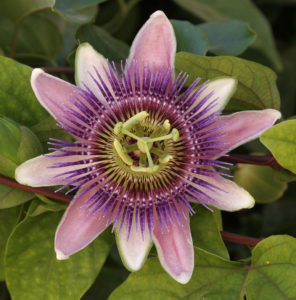 sion flowers, the heliconias, torch
sion flowers, the heliconias, torch 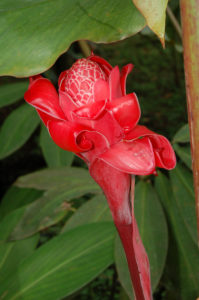 ginger, and the myriad species of orchids. Here at home, I am captivated by the loveliness of spring beauty and Dutchman’s breeches, catalpa and Virginia bluebell, Silphium and blazing star. They all seem to go beyond the bounds of practicality. The rich diversity of colors,
ginger, and the myriad species of orchids. Here at home, I am captivated by the loveliness of spring beauty and Dutchman’s breeches, catalpa and Virginia bluebell, Silphium and blazing star. They all seem to go beyond the bounds of practicality. The rich diversity of colors,  shadings, crenellations, and flamboyancy seem to defy all reason.
shadings, crenellations, and flamboyancy seem to defy all reason.
There is Beauty Within the Animal Kingdom As Well
Even a cursory reflection upon the vast array of animals whose beauty has caught my attention over the years yields a similar cornucopia of examples. The clouded leopard for instance; surely a tawny coat and a few spots would 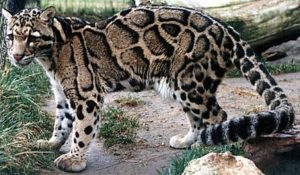 serve as sufficient camouflage within the middle layers of the rainforest. But no, this extraordinary cat is covered in a myriad of blotches of multitudinous shades from white to gray, fawn to black, sand to sepia. Arranged in a bedazzling array of smudges, spots, ovals, oblongs, and squares their coat renders them nearly invisible within their tropical forest home. But I can’t help but perceive that the pattern of their coat goes well beyond the bounds of a super-efficient camouflage. I cannot look at a clouded leopard and not find myself stunned by its absolutely exquisite beauty. I invariably feel a visceral emotion that is totally divorced from my understanding of the biological mechanisms which bring about this beauty. I dare say the feeling is more akin to the sensation I receive when contemplating an impressionist painting or listening to the opening strains of Beethoven’s Violin Concerto in D major.
serve as sufficient camouflage within the middle layers of the rainforest. But no, this extraordinary cat is covered in a myriad of blotches of multitudinous shades from white to gray, fawn to black, sand to sepia. Arranged in a bedazzling array of smudges, spots, ovals, oblongs, and squares their coat renders them nearly invisible within their tropical forest home. But I can’t help but perceive that the pattern of their coat goes well beyond the bounds of a super-efficient camouflage. I cannot look at a clouded leopard and not find myself stunned by its absolutely exquisite beauty. I invariably feel a visceral emotion that is totally divorced from my understanding of the biological mechanisms which bring about this beauty. I dare say the feeling is more akin to the sensation I receive when contemplating an impressionist painting or listening to the opening strains of Beethoven’s Violin Concerto in D major.
The Loveliness of Birds
If we venture to look within the avian world, the examples of beauty transpiring into the irrationally gorgeous are everywhere. Even the non-biologist will likely seize upon the male peafowl as just such an animal. I am taxed to know where to begin when contemplating the beauty of birds. For  sheer elegance of form what could surpass the stealthily wading great egret or the striding black-necked stilt? What figures in motion are more graceful than the dynamic soaring of a wandering albatross or the lazy circling of a red-tailed hawk riding upon its invisible donut of air? Should we want to rank the beauty of
sheer elegance of form what could surpass the stealthily wading great egret or the striding black-necked stilt? What figures in motion are more graceful than the dynamic soaring of a wandering albatross or the lazy circling of a red-tailed hawk riding upon its invisible donut of air? Should we want to rank the beauty of 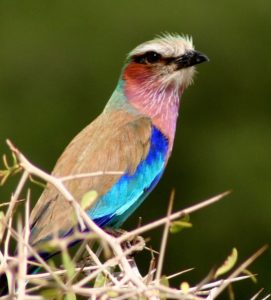 birds based upon their color, we might find that this too is not so simple. The colors and forms exhibited among the Aves seem nearly infinite. How could I hope to choose a winner from among the likes of Tanzania’s lilac-breasted roller, Costa Rica’s resplendent quetzal, our American wood duck, Malaysia’s Argus
birds based upon their color, we might find that this too is not so simple. The colors and forms exhibited among the Aves seem nearly infinite. How could I hope to choose a winner from among the likes of Tanzania’s lilac-breasted roller, Costa Rica’s resplendent quetzal, our American wood duck, Malaysia’s Argus  pheasant, or Peru’s masked trogon? Though I understand the adaptive nature of beak, wing and leg, I still cannot fully fathom why I am compelled to stare at such birds in dumbstruck reverence.
pheasant, or Peru’s masked trogon? Though I understand the adaptive nature of beak, wing and leg, I still cannot fully fathom why I am compelled to stare at such birds in dumbstruck reverence.
Cold-blooded Finery
Most folks would perhaps find it more difficult than I to discern remarkable beauty among the cold-blooded clans that populate our earth. But here too I see this wondrous tendency for nature to seemingly overdo it when it comes to adorning the creatures of our world. Consider the Gaboon viper. It is so venomous, so frightening in its deadly potential. Yet, I cannot sidestep the 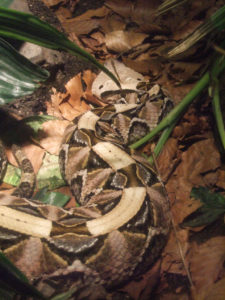 fact that it is an animal of great esthetic beauty. Lying quietly upon a bed of leaves, this serpent becomes virtually invisible. The rich mixture of browns, blacks, fawns, yellows, creams, and whites are arranged in an intricate pattern of blotches, rectangles, and leafy shapes that make it astonishingly difficult to distinguish. Looking upon one of these snakes, I must convince myself that an artist of supreme skill has not surreptitiously sneaked into the reptile house by night and completed a marvelous job of body painting
fact that it is an animal of great esthetic beauty. Lying quietly upon a bed of leaves, this serpent becomes virtually invisible. The rich mixture of browns, blacks, fawns, yellows, creams, and whites are arranged in an intricate pattern of blotches, rectangles, and leafy shapes that make it astonishingly difficult to distinguish. Looking upon one of these snakes, I must convince myself that an artist of supreme skill has not surreptitiously sneaked into the reptile house by night and completed a marvelous job of body painting
The fresh and saltwater fishes are certainly not to be outdone. I find myself as adrift as I am with the birds when it comes to picking a winner in their 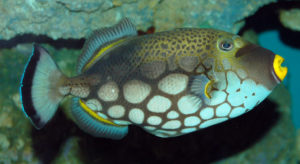 most beautiful contest. Rainbow trout, rainbow darter, clown triggerfish, dolphinfish, Achilles tang, lion fish, angel fish, and Moorish idol. How could I
most beautiful contest. Rainbow trout, rainbow darter, clown triggerfish, dolphinfish, Achilles tang, lion fish, angel fish, and Moorish idol. How could I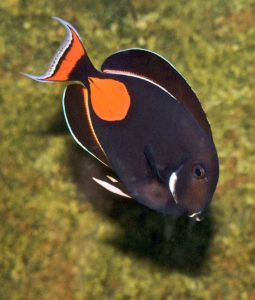 choose from this kaleidoscopic of blues, greens, yellows, oranges, reds, and golds? Scientifically, rationally we know that the color patterns of these fishes may serve to camouflage, to distinguish sexes, to identify a species. But do their
choose from this kaleidoscopic of blues, greens, yellows, oranges, reds, and golds? Scientifically, rationally we know that the color patterns of these fishes may serve to camouflage, to distinguish sexes, to identify a species. But do their  colors really have to be so varied, their forms so diverse, their hues so subtle, and their shades so delicate? Something tells me they do not.
colors really have to be so varied, their forms so diverse, their hues so subtle, and their shades so delicate? Something tells me they do not.
Whence Comes Beauty, Complexity, and Diversity
Such organisms have led me to believe that there may be more to the astounding beauty of our planet’s biodiversity than I once imagined. I am still highly confident in the ability of science to elucidate the mechanisms by which species arise, to explain our own origins, to illuminate the temporal history of the cosmos. No problem there. But my ruminations upon the often profound beauty of earth’s organisms intuit something lying much deeper and it is this. The universe is permeated by a creative force that has, over time, generated ever-increasing complexity and diversity. The excessive loveliness found among earth’s creatures suggests that we need to recognize another procreative tendency. This prodigious, inscrutable creative force is also inclined to generate extreme beauty. Surely the number of people who have communed with the natural world, seen its inordinate beauty and not sensed this Creative Energy, this Great Mystery must be small indeed.
In an essay entitled Guacamaja, Aldo Leopold speaks of an “imponderable essence” which is associated with the material things of an ecosystem. It is this quintessence which gives character, beauty, and aura to a place. In his example, the autumnal north woods is: [land + red maple + grouse]. “. . . 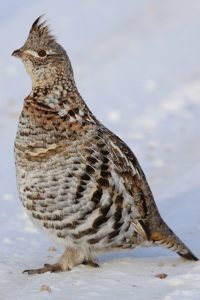 subtract the grouse and the whole thing is dead.” The essence responsible for the unquantifiable quality of the north woods Leopold called the noumenon of material things. It stands in opposition to a phenomenon, something that is concrete and subject to empirical study. Could it be that complexity, diversity, and beauty are reflections of the noumenon that generates the sense of awe we often experience in the natural world? Is it this noumenon, this unquantifiable presence that compel s us to experience with an emotion akin to religious awe a soaring flock of cranes, a flowering prairie, the north woods?
subtract the grouse and the whole thing is dead.” The essence responsible for the unquantifiable quality of the north woods Leopold called the noumenon of material things. It stands in opposition to a phenomenon, something that is concrete and subject to empirical study. Could it be that complexity, diversity, and beauty are reflections of the noumenon that generates the sense of awe we often experience in the natural world? Is it this noumenon, this unquantifiable presence that compel s us to experience with an emotion akin to religious awe a soaring flock of cranes, a flowering prairie, the north woods?
Was Leopold a Prophet for Our Time?
Aldo Leopold was a scholar of great breadth. His mind plumbed the depths of the discipline we now call ecology as well as those of wildlife management, conservation and yes, religious philosophy. Leopold’s classic, A Sand County Almanac makes frequent use of scriptural content and metaphor. Gavin Van Horn, writing in the Journal for the Study of Religion, Nature, and Culture, suggests “ . . . Leopold’s work continues to endure . . . because he subtly traversed the realm of metaphysics in his writing, creating a challenging dialogue between the sciences and humanities.” An essay entitled Goose Music, written by Leopold in the early 1920’s, is a good illustration of  Van Horn’s view. Within that essay lies this passage. “I heard of a boy once who was brought up an atheist. He changed his mind when he saw that there were a hundred-odd species of warblers, each bedecked like to the rainbow. . . No fortuitous concourse of elements working blindly through any number of millions of years could account for why warblers are so beautiful. No mechanistic theory . . . has ever quite answered for the colors of the cerulean warbler, or the vespers of the wood thrush, or the swansong, or goose music”. Leopold ended his ruminations upon the boy who came to believe with these words. “There are yet many boys to be born who, like Isaiah, may see, and know and consider, and understand together, that the hand of the Lord hath done this.”
Van Horn’s view. Within that essay lies this passage. “I heard of a boy once who was brought up an atheist. He changed his mind when he saw that there were a hundred-odd species of warblers, each bedecked like to the rainbow. . . No fortuitous concourse of elements working blindly through any number of millions of years could account for why warblers are so beautiful. No mechanistic theory . . . has ever quite answered for the colors of the cerulean warbler, or the vespers of the wood thrush, or the swansong, or goose music”. Leopold ended his ruminations upon the boy who came to believe with these words. “There are yet many boys to be born who, like Isaiah, may see, and know and consider, and understand together, that the hand of the Lord hath done this.”
What he meant by “the Lord’ is, I would surmise, open to as many interpretations as there are systems of belief (or non-belief). Throughout history we humans have tried to personalize the mysterious Creative Power – this Lord – which underlies the extravagant complexity, diversity, and beauty of the cosmos. We have given names: Allah, Brahma, Tuhan, Jehovah, Krishna, Wakan Tanka, Ngai, the Tao, and God. Our naming and anthropomorphic visualizations are attempts to grasp what we instinctively feel but cannot fully understand due to the powerfully enigmatic character of this Creative Force. Mythologist Joseph Campbell defined God as, “a personification of that world-creative energy and mystery which is beyond thinking and beyond naming.” I’m afraid that, at this point, I can come no closer to true understanding. Given the miracle that is life on earth, perhaps this is enough.
Mr. Van Horn’s suggestion that Leopold navigated the realm of the numinous is intriguing. There is indeed the fragrance of metaphysics, the delicate scent of the mystic in many of Leopold’s essays. We should recall that his land ethic thinking is recognized as one of Leopold’s most enduring contributions to conservation philosophy. Could it be that his understanding of the significance, as well as the source, of the loveliness found within the natural world was just as deeply insightful? If so, perhaps in contemplating the beauty of the life forms around us, we like the boy of Leopold’s story may come to “understand together, that the hand of the Lord hath done this.”
Photo Credits:
1. passion flower by Tomes Castelazo @ commons.wikimedia.org
2. torch ginger by George Sly
3. bird of paradise plant by Soumyoo @ commons.wikimedia.org
4. clouded leopard by SA @ commons.wikimedia.org
5. black-necked stilt by Andy Reago & Chrissy McClassen @ commons.wikimedia.org
6. lilac-breasted roller by David Meeker @ commons.wikimedia.org
7. wood duck by Judy Gallagher @ commons.wikimedia.org
8. Gaboon viper by Life As Art/Tamara @ commons.wikimedia.org
9. clown triggerfish by Derek Ramsey @ commons.wikimedia.org
10. Achilles tang by Jean @ commons.wikimedia.org
11. Moorish idol by Namal Kapadia @ commons.wikimedia.org
12. ruffed grouse by D. Faulder @ commons.wikimedia.org
13. the metaphysical mind courtesy Marabella Intl. Univ. Centre
